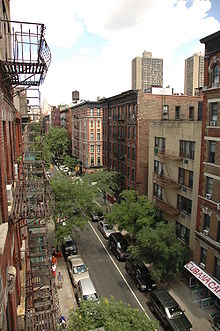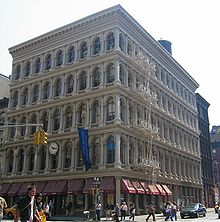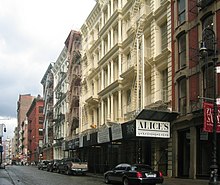SoHo (Manhattan)


SoHo is a neighborhood in the Manhattan borough of New York . The name is derived from South of Houston Street and at the same time an allusion to the trendy London district of Soho . Houston Street is the northern limit of SoHo. In the south, SoHo extends to Canal Street . The Tribeca district (Triangle Below Canal Street) is located below Canal Street in west Manhattan . In the north, SoHo is bordered by New York University , Washington Square Park , Greenwich Village and some streets that are sometimes referred to as NoHo ("North of Houston Street") based on SoHo . However, it is disputed whether this small area should be viewed as an independent district. SoHo is considered a trendy district.
history
The first settlements on the hilly moorland emerged around 1785, when Broadway , which until then ended in Canal Street south of SoHo, was extended northwards by Dutch settlers.
Manhattan was still independent in 1811. The urban planners of the time developed the so-called " Commissioners' Plan ". This resulted in the right-angled street grid that still exists today, known as the grid .
In the period between 1800 and 1850, Manhattan's affluent resident population increasingly settled in what is now SoHo, and in this way quickly attracted a wide variety of businesses, especially along Broadway . Hotels, theaters, upscale shops and stately apartment buildings sprouted like mushrooms, creating a diverse and lively social life.
The SoHo district in today's architectural appearance was finally created around 1850–1890, when the resident population increasingly moved to the more northerly districts of Manhattan and, in particular, the textile industry set up production and storage facilities in SoHo. The area developed into a run-down slum , where factory workers worked for low wages and under poor conditions in so-called sweat shops . In the 1960s, these circumstances were ended by new labor regulations, which led to a downright flight of the manufacturing industry from SoHo, and thus to an extensive orphaned the entire district.
The mostly empty industrial buildings, which are slowly decaying, were increasingly occupied by young artists and freelancers who set up extremely inexpensive studios in the spacious open floors, which were formerly used for production purposes, but also by initially illegally converting the commercial space Living space furnished spacious loft apartments under mostly provisional circumstances for the time being. In the course of the 1970s and 1980s, extensive refurbishment and modernization resulted in coveted and expensive residential and commercial space, the rents of which are now among the highest in New York.
In a few decades SoHo has changed through a multiple gentrification process . The generation of young, up-and-coming artists and intellectuals pioneered the reclamation of the district as a place to live, created a new, attractive environment and brought capital to the district by increasing their own incomes. The increased milieu in turn ensured that real estate speculators discovered their opportunities, which means that the pioneering generation is now at the mercy of a segregation process and is increasingly being displaced from the district by wealthier residents.
architecture
The core of SoHo, the Cast-Iron Historic District , was placed under monument protection due to the special cast iron construction of the warehouse and factory buildings developed in the American Wilhelminian period from 1840 to 1890. However, this cultural treasure was almost lost when an expressway was planned across SoHo in 1962 in order to achieve a better connection between north and south Manhattan. After massive protests, these plans were discontinued in 1968. In 1971, the artist community finally won the legal battle for the preservation of the warehouses.
Cast iron was first used as a decorative element. The iron elements were industrially prefabricated and used to give older buildings in the style of historicism a modern, decorative character. Later, the use of cast iron facades developed into a central, load-bearing structural feature of the building. Its load-bearing structure allowed large window areas, the renouncement of masonry facades reduced the construction costs and allowed very short construction times of a few months. The interiors became larger and more functional through the use of slender, cast iron columns. Incidentally, the material allowed maximum design freedom: In keeping with the style of the time, set pieces from French and Italian Baroque and Renaissance buildings were poured into the facade structures , which were painted white or beige to give them the appearance of a stone facade. There are a total of about 250 cast iron buildings in Manhattan , most of them in SoHo.
In the heyday of cast iron architecture, it was thought that cast iron was more solid and fireproof than steel. For this reason, cast-iron facades were often built in front of wooden buildings. As it was then discovered, however, the iron yielded under the influence of heat just like steel and cracked as soon as it came into contact with extinguishing water. In 1899, new building regulations were issued that required the cast iron facades to be backed with solid masonry. Many of the remaining cast iron buildings in SoHo were built according to this principle.
Arts and Culture
The SoHo “artists' quarter” was created in the 1960s. This is where the protagonists of the Fluxus and experimental film scenes met to hold meetings with poetry readings, happenings , performance art and so on in the shabby and empty factory floors. George Maciunas is seen as the driving force , who wanted to buy the extremely cheap factory buildings "wholesale" and to build an alternative, non-commercial culture in the district. In the 1970s, a movement of avant-garde jazz musicians came together in New York. Sam Rivers opened his Rivbea Studio in 1971 in the basement of a former factory building in the heart of the NoHo district. The studio named after Rivers wife Bea soon became the home of the loft jazz avant-garde . In the course of the 1970s, numerous jazz clubs sprang up in SoHo, where famous jazz personalities performed their art for a small fee. The avant-garde era slowly ended in the late 1970s, when clubs became more commercial and SoHo became too expensive for "the scene".
Since then, SoHo has increasingly developed into a tourist center and a shopping mile for lovers of high-quality fashion labels. In particular, international fashion groups such as B. Chanel , show presence in SoHo with representative branches, which drove the rents for the long-established artist scene to unaffordable heights.
In addition to well over a hundred, mostly avant-garde galleries and numerous antique dealers, SoHo is home to the New Museum of Contemporary Art and the Museum Of African Art. The Guggenheim SoHo of the Solomon R. Guggenheim Foundation was closed in 2002, and the building has been home to one since then Prada store.
See also
Web links
- History SoHo (English)
Coordinates: 40 ° 43 ′ 29 ″ N , 74 ° 0 ′ 0 ″ W.


